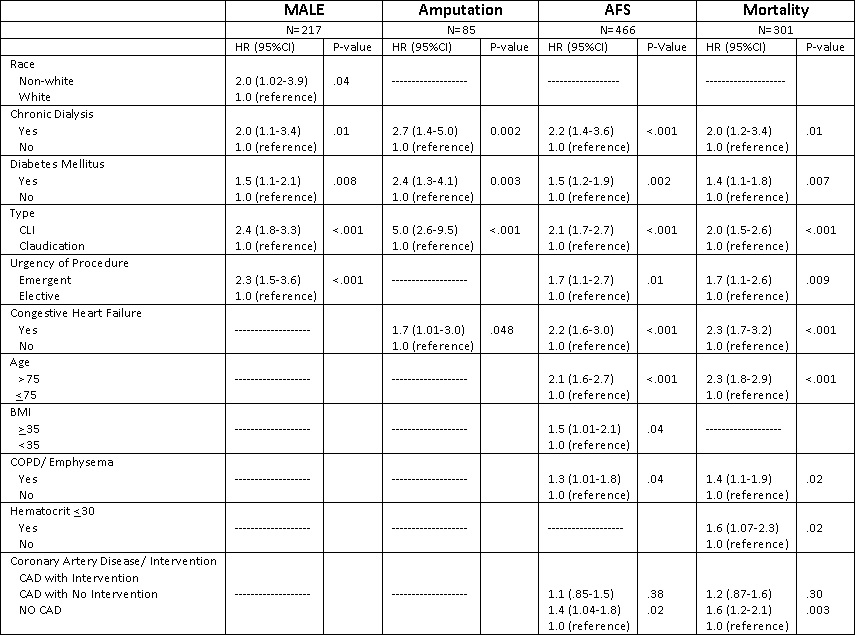|
Back to 2015 Annual Symposium Program
Increasing Obesity Adversely Affects Limb Salvage Following Lower Extremity Revascularization in a 20 year Population Based Study
Animesh Rathore, MBBS, Manju Kalra, MBBS, Jeffrey A. Nienaber, MD, Thomas Bower, MD, Audra A. Duncan, MD, Gustavo Oderich, MD, Randall De Martino, MD, Mark Fleming, MD, Peter Gloviczki, MD, Courtney Heins, William S. Harmsen.
Mayo Clinic, Rochester, MN, USA.
OBJECTIVE:
We have previously reported trends of decreasing amputations along with increasing endovascular interventions for peripheral arterial disease (PAD) in a defined population between 1990 and 2009. The aim of this study was to analyze preoperative risk factors affecting outcomes in these patients.
METHODS:
A retrospective cohort study of residents of a single county was conducted. Procedures were identified by ICD9/CPT codes and data collected through chart review. Endpoints of the study were major adverse limb events (MALE)), major amputations (AMPU), amputation-free survival (AFS) and mortality. Statistical analysis was performed using the Cox-proportional hazards model.
RESULTS:
A total of 1906 lower extremity procedures were performed in 957 person limbs with PAD; 622 patients (M/F: 363/259) with a mean age 67.8 years, (range 27-98). These included open (713), endovascular (610), hybrid (75) revascularizations; primary (192) and secondary (340) amputations. Half the procedures (52%) were performed for critical limb ischemia (CLI) and 7% were emergent. The study population was predominantly white (96 %); comorbidities included dyslipidemia (62%), coronary artery disease (CAD, 47%) 26% with prior intervention, current smoking (42%), diabetes mellitus (DM, 37%) and renal insufficiency (RI, S. creatinine >2.0, 8%). On univariate analysis the most significant risk factor associated with MALE and AMPU was presence of CLI (HR 3.1 / 7.1), followed by RI on dialysis (HR 3.2 /5.2), emergent procedure (HR 3.0 / 2.5), DM (HR 2.0 / 3.9) and CHF (HR 1.9 / 3.4). The prevalence of significant obesity (BMI >35) increased from 6% in the 5 year interval 1990-94 to 12% in 2005-09, and was also significantly associated with MALE, AMPU and AFS (HR 2.4 / 4.3 / 1.5). In addition, factors associated with AFS and mortality included, age > 75 years (HR 2.4 / 2.8), anemia (HR 2.7 / 2.8), CAD without intervention (HR 1.6 / 1.8). Table I summarizes multivariate analysis for factors significantly associated with all endpoints.
CONCLUSIONS:
This population based study confirms the traditional risk factors for adverse outcomes following revascularization for PAD. Severe obesity is emerging as an important risk factor not previously reported especially in light of increasing incidence in the population.

Back to 2015 Annual Symposium Program
|







